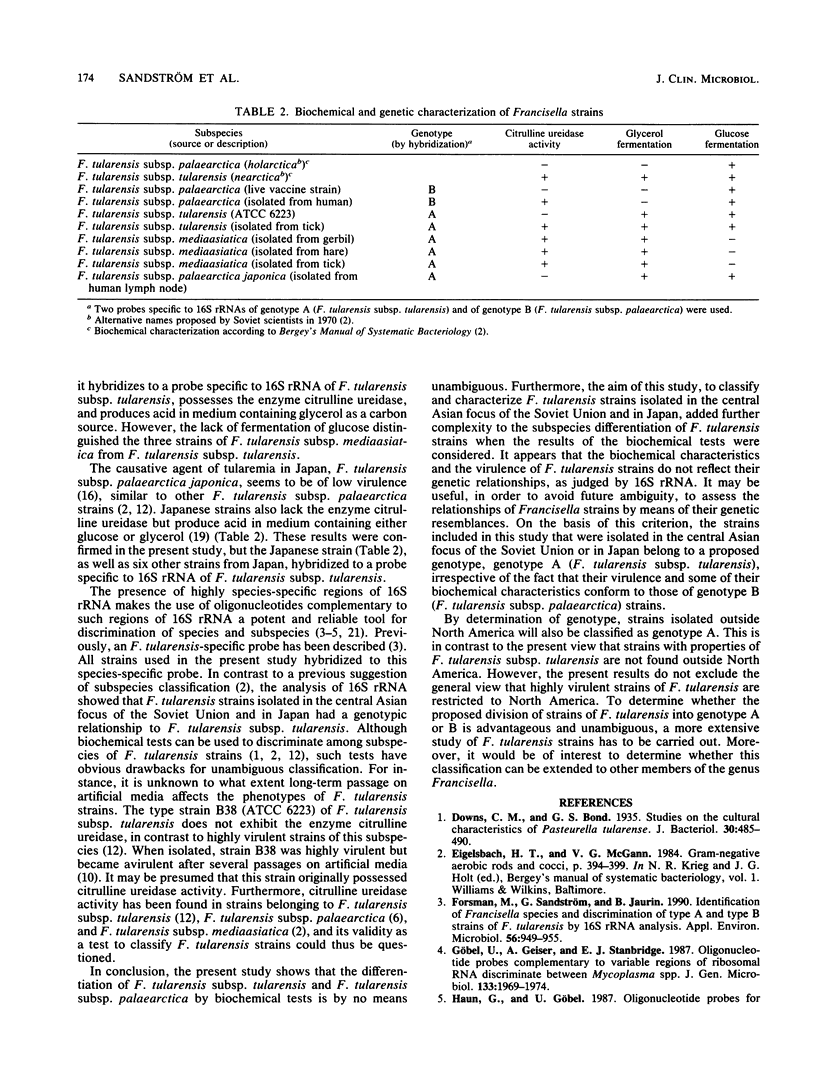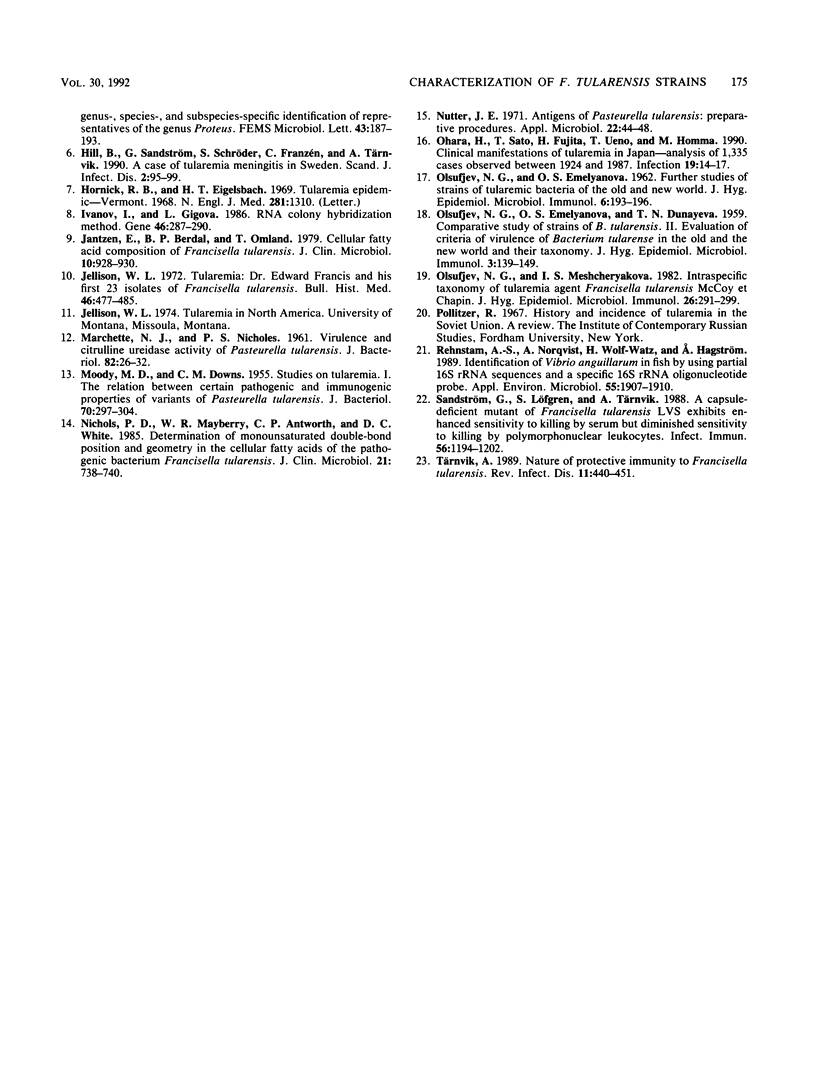Abstract
The two subspecies of Francisella tularensis, F. tularensis subsp. tularensis (type A) and F. tularensis subsp. palaearctica (type B), differ from each other in biochemistry and virulence. Strains of F. tularensis subsp. tularensis are believed to be confined to North America, whereas strains of F. tularensis subsp. palaearctica occur in Europe, in Asia, and in North America. Moreover, the existence of two other subspecies, designated F. tularensis subsp. mediaasiatica and F. tularensis subsp. palaearcitica japonica, has been suggested for strains of F. tularensis isolated in the central Asian focus of the Soviet Union and in Japan, respectively. In the present study, strains biochemically classified as F. tularensis subsp. mediaasiatica or F. tularensis subsp. palaearctica japonica have been investigated by hybridization with probes specific to 16S rRNAs of the two main subspecies. Furthermore, the virulence and biochemical characteristics of the strains were compared with those of strains belonging to F. tularensis subsp. palaearctica and F. tularensis subsp. tularensis. It was found that 16S rRNAs of F. tularensis subsp. mediaasiatica and F. tularensis subsp. palaearctica japonica hybridize with the probe specific to a genotype proposed herein, genotype A (F. tularensis subsp. tularensis), which shows that strains genetically related to this subspecies are found outside North America. However, the central Asian strains differed from F. tularensis subsp. palaearctica and F. tularensis subsp. tularensis strains when investigated by fermentation of glucose. The results of the biochemical tests could not be unambiguously used for differentiation of strains into F. tularensis subsp. palaearctica or F. tularensis subsp. tularensis. These drawbacks suggest that classification of strains of Francisella on the basis of 16S rRNA analysis may be preferable to classification on the basis of biochemical analysis.
Full text
PDF



Selected References
These references are in PubMed. This may not be the complete list of references from this article.
- Downs C. M., Bond G. C. Studies on the Cultural Characteristics of Pasteurella tularense. J Bacteriol. 1935 Nov;30(5):485–490. doi: 10.1128/jb.30.5.485-490.1935. [DOI] [PMC free article] [PubMed] [Google Scholar]
- Forsman M., Sandström G., Jaurin B. Identification of Francisella species and discrimination of type A and type B strains of F. tularensis by 16S rRNA analysis. Appl Environ Microbiol. 1990 Apr;56(4):949–955. doi: 10.1128/aem.56.4.949-955.1990. [DOI] [PMC free article] [PubMed] [Google Scholar]
- Göbel U. B., Geiser A., Stanbridge E. J. Oligonucleotide probes complementary to variable regions of ribosomal RNA discriminate between Mycoplasma species. J Gen Microbiol. 1987 Jul;133(7):1969–1974. doi: 10.1099/00221287-133-7-1969. [DOI] [PubMed] [Google Scholar]
- Hill B., Sandström G., Schröder S., Franzén C., Tärnvik A. A case of tularemia meningitis in Sweden. Scand J Infect Dis. 1990;22(1):95–99. doi: 10.3109/00365549009023126. [DOI] [PubMed] [Google Scholar]
- Hornick R. B., Eigelsbach H. T. Tularemia epidemic--Vermont, 1968. N Engl J Med. 1969 Dec 4;281(23):1310–1310. doi: 10.1056/NEJM196912042812325. [DOI] [PubMed] [Google Scholar]
- Ivanov I., Gigova L. RNA colony hybridization method. Gene. 1986;46(2-3):287–290. doi: 10.1016/0378-1119(86)90413-0. [DOI] [PubMed] [Google Scholar]
- Jantzen E., Berdal B. P., Omland T. Cellular fatty acid composition of Francisella tularensis. J Clin Microbiol. 1979 Dec;10(6):928–930. doi: 10.1128/jcm.10.6.928-930.1979. [DOI] [PMC free article] [PubMed] [Google Scholar]
- Jellison W. L. Tularemia: Dr. Edward Francis and his first 23 isolates of Francisella tularensis. Bull Hist Med. 1972 Sep-Oct;46(5):477–485. [PubMed] [Google Scholar]
- MARCHETTE N. J., NICHOLES P. S. Virulence and citrulline ureidase activity of Pasteurella tularensis. J Bacteriol. 1961 Jul;82:26–32. doi: 10.1128/jb.82.1.26-32.1961. [DOI] [PMC free article] [PubMed] [Google Scholar]
- MOODY M. D., DOWNS C. M. Studies on tularemia. I. The relation between certain pathogenic and immunogenic properties of variants of Pasteurella tularensis. J Bacteriol. 1955 Sep;70(3):297–304. doi: 10.1128/jb.70.3.297-304.1955. [DOI] [PMC free article] [PubMed] [Google Scholar]
- Nichols P. D., Mayberry W. R., Antworth C. P., White D. C. Determination of monounsaturated double-bond position and geometry in the cellular fatty acids of the pathogenic bacterium Francisella tularensis. J Clin Microbiol. 1985 May;21(5):738–740. doi: 10.1128/jcm.21.5.738-740.1985. [DOI] [PMC free article] [PubMed] [Google Scholar]
- Nutter J. E. Antigens of Pasteurella tularensis: preparative procedures. Appl Microbiol. 1971 Jul;22(1):44–48. doi: 10.1128/am.22.1.44-48.1971. [DOI] [PMC free article] [PubMed] [Google Scholar]
- OLSUFIEV N. G., EMELYANOVA O. S., DUNAYEVA T. N. Comparative study of strains of B. tularense in the old and new world and their taxonomy. J Hyg Epidemiol Microbiol Immunol. 1959;3:138–149. [PubMed] [Google Scholar]
- OLSUFYEV N. G., EMELYANOVA O. S. Further studies of strains of tularaemic bacteria of the old and new world. J Hyg Epidemiol Microbiol Immunol. 1962;6:193–205. [PubMed] [Google Scholar]
- Ohara Y., Sato T., Fujita H., Ueno T., Homma M. Clinical manifestations of tularemia in Japan--analysis of 1,355 cases observed between 1924 and 1987. Infection. 1991 Jan-Feb;19(1):14–17. doi: 10.1007/BF01643750. [DOI] [PubMed] [Google Scholar]
- Olsufjev N. G., Meshcheryakova I. S. Infraspecific taxonomy of tularemia agent Francisella tularensis McCoy et Chapin. J Hyg Epidemiol Microbiol Immunol. 1982;26(3):291–299. [PubMed] [Google Scholar]
- Rehnstam A. S., Norqvist A., Wolf-Watz H., Hagström A. Identification of Vibrio anguillarum in fish by using partial 16S rRNA sequences and a specific 16S rRNA oligonucleotide probe. Appl Environ Microbiol. 1989 Aug;55(8):1907–1910. doi: 10.1128/aem.55.8.1907-1910.1989. [DOI] [PMC free article] [PubMed] [Google Scholar]
- Sandström G., Löfgren S., Tärnvik A. A capsule-deficient mutant of Francisella tularensis LVS exhibits enhanced sensitivity to killing by serum but diminished sensitivity to killing by polymorphonuclear leukocytes. Infect Immun. 1988 May;56(5):1194–1202. doi: 10.1128/iai.56.5.1194-1202.1988. [DOI] [PMC free article] [PubMed] [Google Scholar]
- Tärnvik A. Nature of protective immunity to Francisella tularensis. Rev Infect Dis. 1989 May-Jun;11(3):440–451. [PubMed] [Google Scholar]


